MOUNTAINS ARE AN ETERNAL SOURCE OF FASCINATION
northern Portugal? Or that first time on a snowboard in the Pyrenees? (which was not particularly successful, in terms of snowboarding that is) But the most likely explanation is, of course, that it was all these experiences that gradually built up my personal love with mountains. Into what it is today, an unconditional love affair that never disappoints.
Mountains exercise a unique hold on the human mind. Is it their majestic grandeur? Is it the unfathomable beauty of the panoramic views from their summits? The colors of a setting sun on a mountain face? Their raw, uncompromising strength, sometimes brutal, sometimes merciless? Whatever it is, people have felt the urge to climb mountains since time immemorial. Mountains inspire; they fire the imagination. In many cases they have a symbolic significance; their very existence teaches us that achieving a goal demands resolve, perseverance, and effort. And whether you’re out to add a few summits of some “four-thousanders” to your track record, or you just love hiking and cycling in spectacular surroundings, or you’re addicted to riding virgin powder down unspoiled, rugged slopes, you can do it all in the mountains.
When exactly my passion for the mountains arose is a little difficult for me to pinpoint. Was it on my trip to Switzerland at twelve years old, or over the course of our family’s many annual vacations in the Black Forest (although I don’t immediately recall too many mountains on those)? Was it that one vacation in the Jura? Or maybe my trekking tour across
I’ve always loved being active and in the outdoors: running, mountaineering, cycling, trekking, snowboarding, rafting... and more recently, under the subtle pressure of having a daughter who’s gone crazy for climbing: real rock climbing, via ferrata, rope courses, adventure parks and that sort of thing. One thing that I love about mountain sports is that they’re not just about physical strength and condition - the mental game also plays a huge role. And that makes the payoffs that much more powerful. Whether that payoff is the breath-taking view from atop a summit, the feeling of freedom and tranquillity, or that salubrious shower after a hard day of mountain biking or splitboarding.
You choose, you lose
I would have loved to have written a book of a thousand pages (maybe more?). Then I wouldn’t have had to make the difficult choices that I did. Then I could have included the climbs up Gran Paradiso and Grande Casse (on snowshoes, with snowboard lashed to my backpack), the mountainbiking in the Scottish Highlands, the hikes over Italian volcanoes, my annual trip to La Grave/La Meije, that time I was in a freeride competition in Bulgaria, my winter climb on Kebnekaise (Sweden’s highest mountain) - which I had to do without baggage, as it spent the entire week in some forsaken corner of an airport somewhere... And so much more. But when you have to make choices, you’re always giving something up. But with
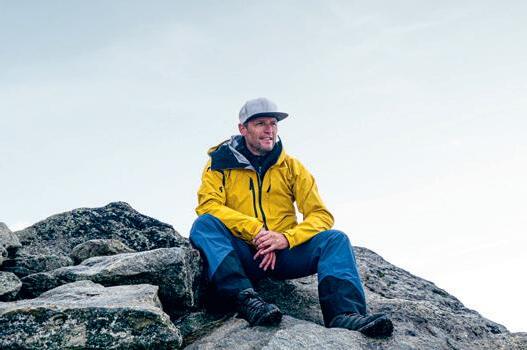
the eighteen areas that did make the cut, and all the sports that come along with them, I hope I’ve included more than enough to make even the most fanatic mountain sports fan excited about this book.
You choose, you lose (part 2)
I often get asked what is my very favorite area. Where’s the best skiing or snowboarding? Where are the best mountain bike trails?
I always give the same, honest answer: I really don’t know. I’m absolutely in love with the jagged rock formations in the Dolomites - both on the Italian side and the Lienzer Dolomites on the Austrian side. But then there’s Cadini de Misurina - couldn’t you just stare in any direction for days and never get bored? But just as much, I love the rugged authenticity of the Querays, as well as the mind-boggling playground you’ll find (both in winter and summer) around fashionable Verbier. The towering giants of Chamonix-Mont-Blanc, the iconic Matterhorn or the (in)famous trio of Eiger/Mönch/Jungfrau make an unforgettable impression, as does the sadly ever-shrinking Aletsch glacier. I don’t mind saying that I still have nightmares about that rafting trip on the untamed Ötztaler Ache (only a slight exaggeration - it was really pretty wild), and discovering the part of the Zillertal that I did, hiking with my family, was truly one of the high points of all the vacations we’ve ever taken. My splitboard tour across Voralberg was a combination of highlights and disappointments at the paths we couldn’t take and the runs left undiscovered. On the mountains in Val Senales I had probably my best time on a mountain bike ever, and in Slovenia I enjoyed not only unbelievably beautiful trails but simply jaw-dropping natural beauty. And then there’s the northern lights, which you simply have to see before you die,
and skiing down a face straight onto a beach on the Arctic Ocean is not something you ever forget either. Or the canyoning and jumping from huge boulders into a churning river. Or...
Mountains or beach?
It’s the age-old question when a family starts talking about where to go on vacation. For me, the choice is clear. But sometimes, wife and daughter really just want to head to the beach. So here I would like to apologize to them both, for all the times in recent years that my unbridled enthusiasm has dragged them into the mountains instead. One day I’ll make it up to you. And we’ll go to a place where the mountains run straight down into the sea. So we’ll all get what we’re looking for.
Special thanks
The stories that appear in this book were never intended to appear in print. When I was floating in a paraglider above Lake Annecy, or tromping through the Spanish Pyrenees in a wetsuit, putting these experiences into a book was certainly the last thing on my mind. And because I wasn’t thinking of doing so, in many cases I do not have photographs of my own trips. For these, in some cases I was able to fill the gaps by approaching outdoor photographers I know, and in others I had to turn to image banks. I would like to use this final note to extend my sincere gratitude to these sources, and to everyone who contributed in any way.
And as my last word, I urge you to get out and go: hike, climb, embrace new experiences and discover the power and majesty of the mountains.
Jurgen Groenwals
‘If you think adventure is dangerous, try routine; it is lethal.’
— Paulo Coelho


High above Lake Annecy
Flight has always fascinated us. There were Leonardo da Vinci and his designs for flying machines, the Montgolfier brothers and their hot air balloon, and the Wright Brothers, who pioneered modern aviation with the first controlled flight in their aircraft. But we could go back all the way to Greek mythology: Icarus, who used his homemade wings in a doomed attempt to fly to the sun. Despite the warnings of his father Daedalus, he flew too close to the sun, which melted his wings and brought him crashing down. A story of hubris, of human vanity - and yet these are things that do not afflict me as I run down a slope and jump off into the air, high above Lake Annecy. Instead my heart is only filled with humility and marvel.
But back to that in a moment. First, you might be wondering: what’s a lake doing in a book about mountains? Well, for starters, Lake Annecy is surrounded by mountains that edge right up to the lake and seem to plunge straight from their summits into the turquoise water. And there’s a lot to experience in and on these mountains (and, of course, in and on the water as well). In the French departements of Savoie and Haute Savoie – united in the tourist region of Savoie Mont Blanc – you will
find four noteworthy lakes: Léman, Le Bourget, Annecy and Aiguebelette (here given in descending order of size). The most famous is, unquestionably Lac Léman (better known as Lake Geneva). In terms of surface area, it’s also the largest of the four, but quite a bit of that is actually in Swiss territory. Something like a small inland sea between France and Switzerland, Lac Léman has a tremendous variety of landscapes and scenery: from vineyards to quaint


Its appellation “the Venice of the Alps” is not misplaced. Nor, for that matter, is its other nickname, the “Pearl of the French Alps”, a tiny treasure nestled on the jagged mountaintops.
fishing villages, to beaches, to harbors and cruise ships. Next comes Le Bourget, which takes its name from the village of Le Bourget-du-Lac. If we leave Lac Léman (partly in France and partly in Switzerland) aside for a moment, Le Bourget is the biggest glacial lake in France.
Then, we come to Lake Annecy, born of the meltwater of France’s glaciers. A good bit smaller, but at nearly 28 km² not exactly a small lake, either. It’s framed by two towering mountain ranges, Bornes and Bauges. Finally, we have the smallest and probably least-known: Aiguebelette. Its emerald-green waters are deliciously warm in spring and summer, and its uninhabited islands and authentic atmosphere make Lake Aiguebelette an absolute hidden gem.
Here you can rent an SUP board and bob on the water surrounded by unforgettable scenery. The average water temperature of 24°C, a breathtaking palette of every shade of blue, some 50 beaches and over 30 harbors make the four lakes of Savoie Mont Blanc a delightful summer destination.
Pearl of the French Alps
So, back to Annecy. On the north shore of the lake lies the old town of Annecy, famous for the canal that runs straight through it. Its appellation “the Venice of the Alps” is not misplaced. Nor, for that matter, is its other nickname, the “Pearl of the French Alps”, a tiny treasure nestled on the jagged mountaintops. With its cobbled streets, meandering canals, pastel-colored houses, and the the Château d’Annecy, Palais de l’île and Pont des Amours, Annecy is a treasure trove of European charm that is certainly worth a visit. It’s an ideal location for a little break to let the adrenaline levels go back to normal after your adventures in the surrounding mountains. But before we take to the air we’re going to give you a couple
of tips for while you’re on terra firma. About twelve kilometers from Annecy, on the way to the Bauges Mountains, you’ll find Fromagerie de la Cochette, a historic dairy farm that has been reborn as a mecca for the production of Reblochon cheese. It’s also worth noting that the Col de la Cochette is the only pass of the Roc des Bœufs that will take you into the Entrevernes, where you’ll get the best views over Lake Annecy. And if you want to go deeper into the mountains on the French side, the Bauges Mountains is where you want to be. If you’re a wine lover I can definitely recommend that you do. Visit Domaine Philippe Grisard, in Cruet, for wines and views that you won’t soon forget.
Or perhaps you’re looking for something a little more active? Then head straight to the Gorges du Fier. The Fier is one of the major rivers of the Haute-Savoie. It’s also a textbook example of water flow erosion. A hiking trail with a number of footbridges takes you through the gorge and gets you up close to all its geological highlights along the way. Finally, I would like to note that Lake Annecy is an extremely clean lake that is perfect for swimming and other water sports.
But for now, let’s say you’ve swum enough, splashed enough, and eaten enough cheese for the time being, and you’re ready to head into the mountains.
Paragliding
Around here, paragliding is also known as “parapente” – both terms are related to the word “parachute”. But while the “chute” in “parachute” actually means “fall”, “pente” means “slope”. That refers to the slope that you run down to start your flight. And while a parachute is designed to break a fall, a paraglider is designed to keep you in the air longer, essentially “flying”. With a paraglider you don’t jump off or out of
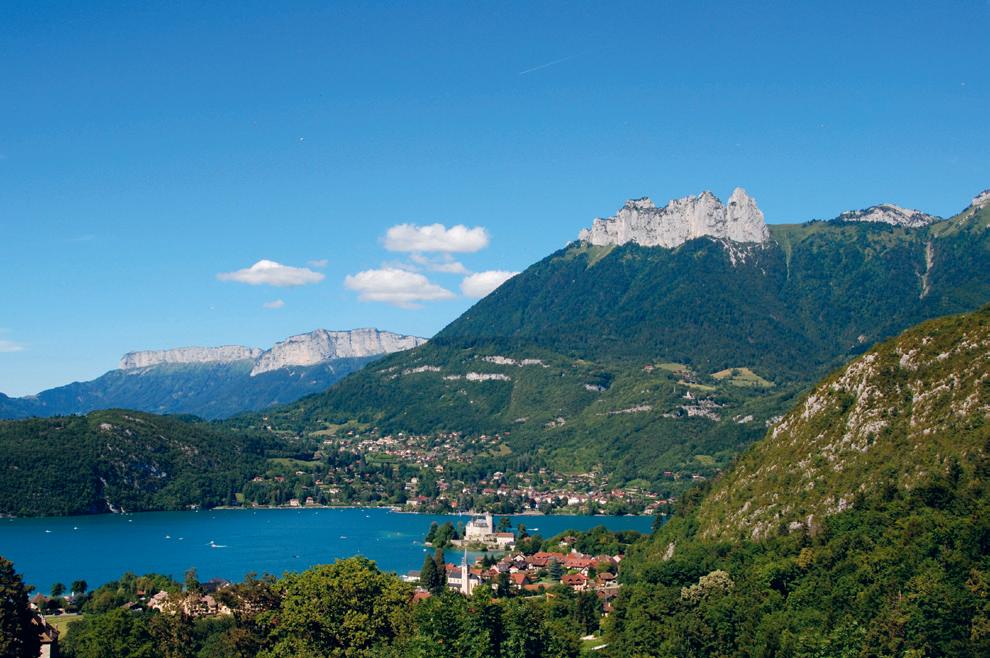
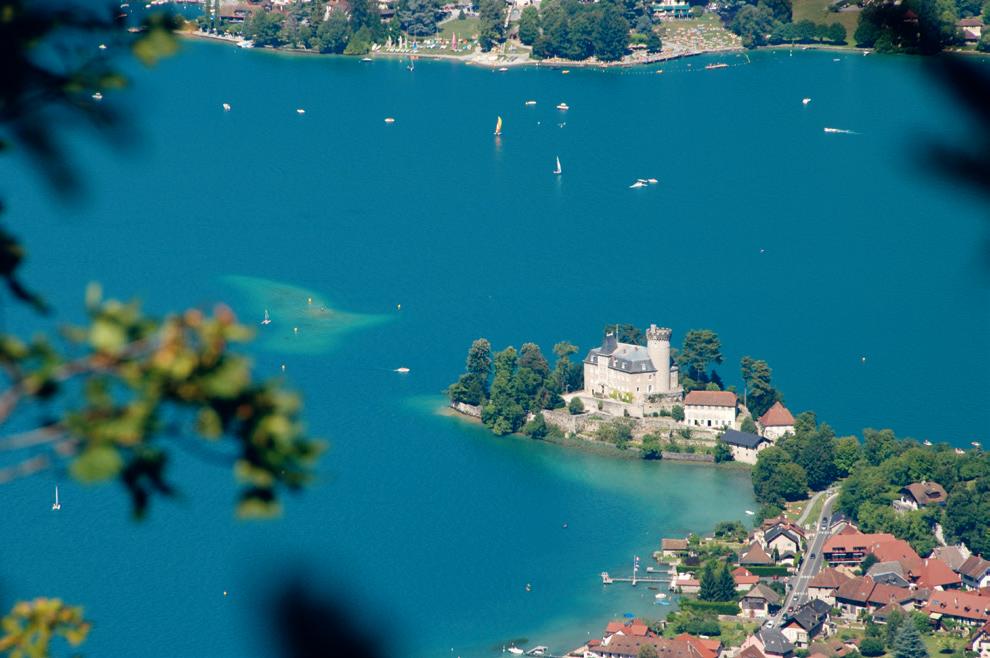


anything, but instead you run down a slope, which causes your wing-shaped chute to fill with air. After a few meters, it’s big enough to support you, and you take off.
Over the years, the chute of a paraglider has evolved to improve control and flight. An important step forward was the modification of the shape from a round chute (like a parachute) to a more rectangular, aerofoil-shaped chute. It was the end of the 1970s when three French paragliders became the first to successfully start from a slope with their wing-shaped chute. In the years that followed, chutes specially designed for paragliders began to appear, and the shape gradually changed from rectangular to more oval-shaped.
Col de la Forclaz
We’re standing on Col de la Forclaz. Far below me, I see Lake Annecy glistening in all its blue beauty. Meanwhile, the pilot has inflated the wing and unfurled my lines. Because unlike a parachute, the wing of a paraglider doesn’t need to absorb shocks, these lines can be made lighter and thinner. My heart races as I reflect on the fact that I only half-listened to the safety briefing. I hear something about the steering lines that allow you to control the left and right sides of the wing to steer, and even slow down.
Annecy is a hotspot for paragliding, one of the best in France and maybe even in Europe. A quick glance at all the wings already in the air here tells you that. And its most famous spot among paragliders is Col de la Forclaz. On a busy day you’ll see over a thousand paragliders taking off from here, and the colorful spectacle plays out above the lake all day long.
But now I’m putting my harness and helmet on. I’ve done my share of skydiving in the past, but it’s been a long time, and I was young and fearless then. It feels different now: my heart is pounding in my throat, and my mouth is bone dry. The pilot grips me tight to himself, and together we wait for the moment of truth. Then he pulls up the sail and together we walk to the edge of the mountain. A few seconds later we’re floating in the air, my fear gives way to euphoria, and the fun starts.
No better view
A mountain panorama always blows me away, but the view from above the mountains? It certainly doesn’t get any better than that. I can see the lake below, of course, but also

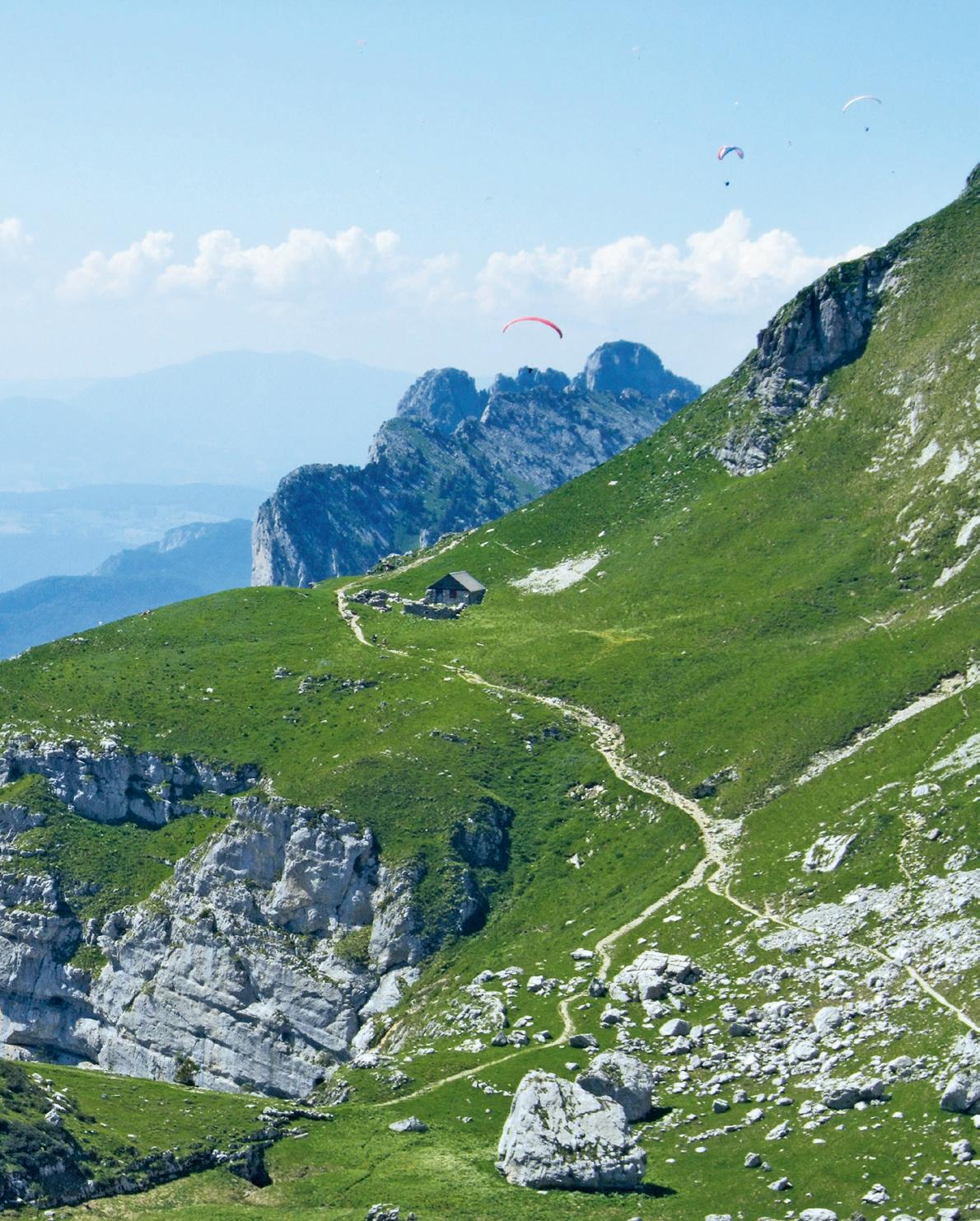
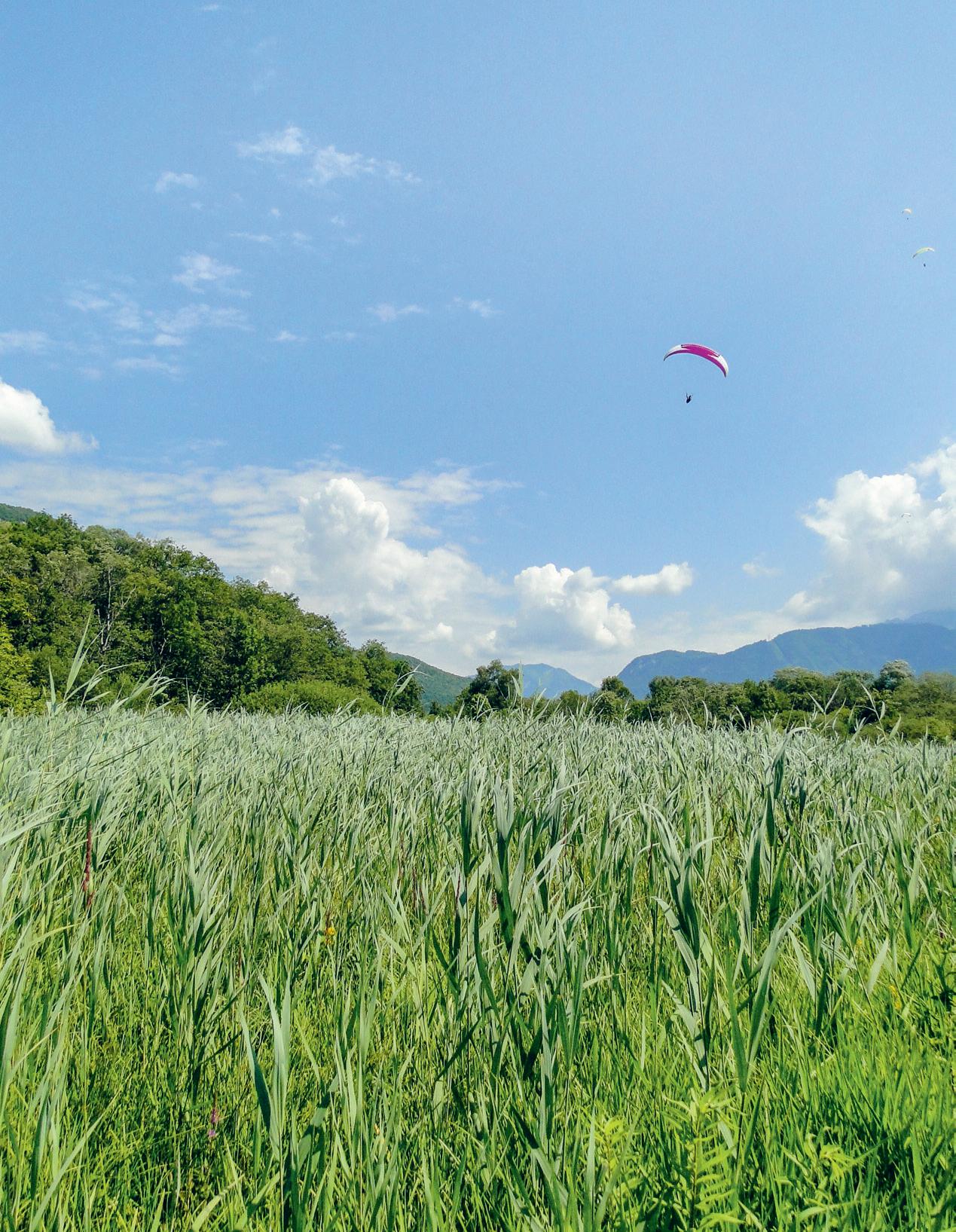

We make sharp turns that make me feel weightless; we spin in full circles. Then I get to take control. Knowing that I’m steering the paraglider gives me goosebumps.
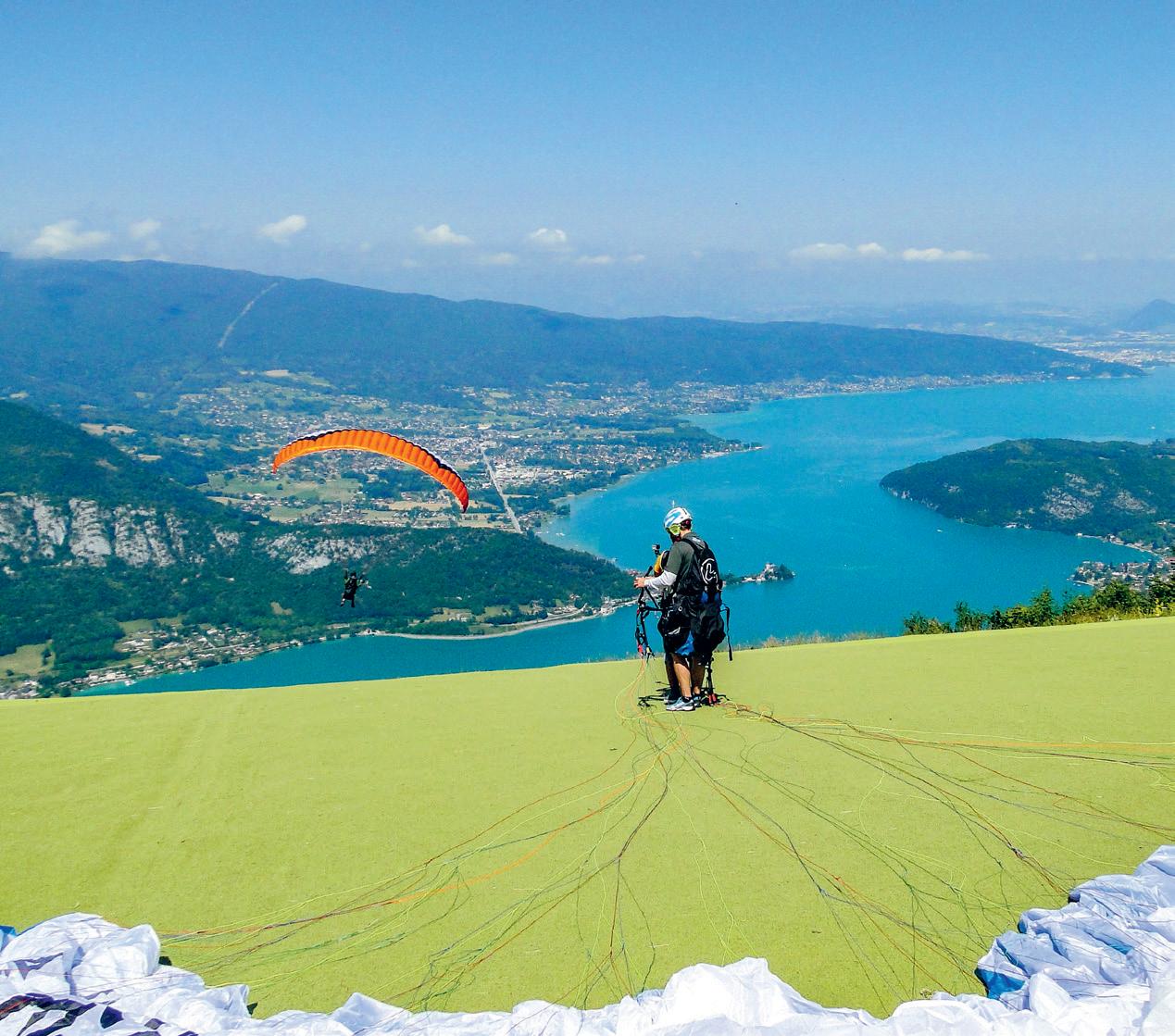
summits such as Semnoz, Dents de Lanfon and Lanfonnet, Tournette, Mont Veyrier, the Bauges Mountains, Chaîne des Aravis, Pointe de la Beccaz, and a whole series of others that I’m too excited to remember. And off in the distance, I can just make out the gleaming white summit of Mont Blanc. A paraglider is also the best place to spot ibex on the very highest mountaintops, by the way. Suddenly we make a sharp turn and fly straight towards a steep mountainside. This is where the thermals, which will give us more altitude, are best. The pilot looks for wind gusts and mountainsides to keep us in the air as long as possible and give us the momentum to bust some aerial moves.
“Feel like some aerial acrobatics?” I hear the pilot ask. My answer is surprisingly simple: “Of course!” I hear something that sounds like “stall”, and then I see my life flash before my eyes as it looks like the wing starts to collapse. We’re falling... until the pilot opens the wing again and we start regaining speed. We make sharp turns that make me feel weightless; we spin in full circles. Then I get to take control. Knowing that I’m steering the paraglider gives me goosebumps.
About an hour later, I see the ground coming a lot closer, and fast. I get instructions about how and when we’re going to make our landing. The speed goes out of the paraglider, and I feel my feet on the ground again. Both the pilot and I keep running for a few more meters, and then it’s over. I’m still trembling on my legs, but I confidently give the pilot a high five and that concludes my first paragliding experience. But my smile is indelibly pressed into my face all day.
Free as a bird
Mostly I remember the pure joy of my paragliding experience in Annecy, although occasionally I also remember the nearheart attack of the takeoff and the heavy thermals... but the thrill of the flying really does push everything else from the memory. It’s with good reason that Annecy is one of the best places in the world for paragliding. Go in the afternoon or early evening for the best thermals, which will give you the longest flight.

